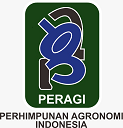Yield Evaluation of Upland Rice Varieties (Oryza sativa L.) in Several Levels of Soil Water Content
Abstract
Keywords
Full Text:
PDFReferences
Bunnag S, Pongthai P. 2013. Selection of rice (Oryza sativa L.) cultivars tolerant to drought stress at the vegetative stage under field conditions. Am J Plant Sci 4(9): 1701-1708
Castillo, E.G., Tuong, T.P., Singh, U., Inubushi, K., and Padilla, J. 2006. Drought Response of Dry-Seeded Rice to Water Stress Timing and N-fertilizer Rates and Sources. Soil Science and Plant Nutrition 52(4): 496-508.
Comas, L.H., Becker, S.R., Cruz, V.M.V., Byrne, P.F., and Dierig D.A., Root traits contributing to plant productivity under drought Front Plant Sci. 2013; 4: 442. Published online 2013 Nov 5. doi: 10.3389/fpls.2013.00442
FAO. [Food and Agriculture Organization]. 2013. FAO Statistical Year Book 2013. World Food and Agriculture. Food and Agriculture Organization of the United Nations. Rome, 2013. ISSN 2225-7373.
Farooq, M., Wahid, A., Kobayashi, N., Fujita, D., and Basra, S.M.A. 2009. Plant Drought Stress: e_ects, mechanisms and management. Agronomy for Sustainable Development, Springer Verlag, 29 (1), pp.185-212.
Gomez, K.A. and Gomez, A.A. (1984) Statistical Procedures for Agricultural Research. 2nd Edition, John Wiley and Sons, New York, 680 p.
Guimarães, C.M., Stone, L.F., Rangel, P.H.N. de L. Silva, A.C.D. 2013. Tolerance of Upland Rice Genotypes to Water Deficit. Revista Brasileira de Engenharia Agrícola e Ambiental v.17, n.8, p.805–810, 2013.
Heinemann, A.B., Dingkuhn, M., Luquet, D., Combres, J.C., and Chapman, S. 2007. Characterization of Drought Stress Environments for Upland Rice and Maize in Central Brazil. Euphytica Volume 162, Issue 3, pp 395-410.
Heinemann, A.B.; Barrios-Perez, C.; Ramirez-Villegas, J.; ArangoLondoño, D.; Bonilla-Findji, O.; Medeiros, J.C.; Jarvis, A. 2015. Variation and impact of drought-stress patterns across upland rice target population of environments in Brazil. Journal of Experimental Botany 66: 3625-3638.
Kementerian Pertanian RI. 2015. Basis Data Statistik Pertanian. Luas Panen, Produksi dan Produktivitas Tanaman Pangan 2010-2019. www.pertanian.go.id. [2 November 2015].
Lafitte, H.R., Yongsheng, G., Yan, S., and Li1, Z.K. 2007. Whole Plant Responses, Key Processes, and Adaptation to Drought Stress: The Case of Rice, J. Exp. Bot. 58, 169–175.
Lanna, A.C., and Vianello, R.P., 2021. Upland Rice: phenotypic diversity for drought tolerance. Crop Science Sci. agric. (Piracicaba, Braz.) 78(5) 2021 https://doi.org/10.1590/1678-992X-2019-0338
Leport, L., Turner N.C., French R.J., Barr M.D., Duda R., Davies S.L. 2006. Physiological responses of chickpea genotypes to terminal drought in a Mediterranean-type environment, Eur. J. Agron. 11,279–291.
Liu H.P., Dong B.H., Zhang Y.Y., Liu Z.P., Liu Y.L. 2004. Relationship between osmotic stress and the levels of free, soluble conjugated and insoluble-conjugated polyamines in leaves of wheat seedlings, Plant Sci. 166, 1261–1267.
Manikavelu A., Nadarajan N., Ganesh S.K., Gnanamalar R.P., Babu R.C. 2006. Drought tolerance in rice: morphological and molecular genetic consideration, Plant Growth Regul. 50, 121–138
Mayly, S., Rauf, A., Hanum, C., and Hanum, H., 2015. Roots Bioassay of Upland Rice Varieties on Several Soil Moisture Gradients. Proceedings of The 5th Annual International Conference Syiah Kuala University (AIC Unsyiah) 2015 In conjunction with The 8th International Conference of Chemical Engineering on Science and Applications (ChESA) 2015 September 9-11, 2015, Banda Aceh, Indonesia
Mostajeran, A., and Rahimi-Eichi, V. 2009. Effect of Drought Stress on Growth and Yield of Rice (Oryza sativa L) Cultivars and Accumulation of Proline and Soluble Sugars in Sheath and Blades of Their Different Ages Leaves, American-Eurasian J. Agric & Environ.Sci., 5 (2) : 264-272.
Pandey, S., and Bhandari, H. 2008. Drought: economic costs and research implications. In: Serraj, R., Bennett, J., Hardy, B. (Eds.), Drought Frontiers in Rice: Crop Improvement for Increased Rainfed Production. World Scientific Publishing and Los Banos (Philippines): International Rice Research Institute, Singapore
Sairam R.K., Srivastava G.C., Agarwal S., and Meena, R.C. 2005. Differences in antioxidant activity in response to salinity stress in tolerant and susceptible wheat genotypes, Biol. Plant. 49, 85–91.
Sarvestani, Z.T., Pirdashti, H., Sanavy, S.A.M.M., and Balouchi, H. 2008. Study of Water Stress Effects in Different Growth Stages on Yield and Yield Components of Different Rice (Oryza sativa L.) Cultivars. Pakistan Journal of Biological Sciences, 11:1303-1309. DOI: 10.3923/pjbs.2008.1303.1309
Shafeeq, S., Rahman, M.U., and Zafar, Y. 2006. Genetic Variability of Different Wheat (Triticum Aestivum L.) Genotypes/Cultivars under Induced Water Stress. Pak. J. Bot., 38(5): 1671-1678, 2006
Siddique M.R.B., Hamid A., and Islam M.S. 2001. Drought stress effects on water relations of wheat, Bot. Bull. Acad. Sinica 41, 35–39.
Syawal, F., Rauf, A., Rahmawaty, R., & Hidayat, B. (2017, November). Pengaruh pemberian kompos sampah kota pada tanah terdegradasi terhadap produktivitas tanaman padi sawah di Desa Serdang Kecamatan Beringin Kabupaten Deli Serdang. In Prosiding SEMDI-UNAYA (Seminar Nasional Multi Disiplin Ilmu UNAYA) (Vol. 1, No. 1, pp. 41-51).
Toha, H.M. 2013. Pengembangan Padi Gogo Mengatasi Kerawanan Pangan Wilayah Marjinal. Dalam Prospek Pertanian Lahan Kering Dalam Mendukung Ketahanan Pangan. Balitbang Pertanian. P 143-163.
Tripathy J.N., Zhang J., Robin S., Nguyen T.T. and Nguyen H.T. 2000. QTLs for cell-membrane stability mapped in rice (Oryza sativa L.) under drought stress, Theor. Appl. Genet. 100, 1197–1202.
Venuprasad, R., Lafitte, H.R., and Atlin, G.N. 2007. Response to direct selection for grain yield under drought stress in rice. Crop Science, 47(1): 285-293
Wu, Q.S., Xia, R.X., and Zou, Y.N. 2008. Improved soil structure and citrus growth after inoculation with three arbuscular mycorrhizal fungi under drought stress. European J. Soil Biol., 44: 122–128
Zhang, M., Duan, L., Zhai, Z., Li, J., Tian, X., Wang, B., He, Z., and Li, Z. 2004. Effects of plant growth regulators on water deficit-induced yield loss in soybean, Proceedings of the 4th International Crop Science Congress Brisbane, Australia.
Refbacks
- There are currently no refbacks.



























